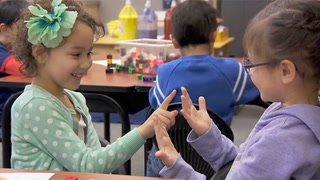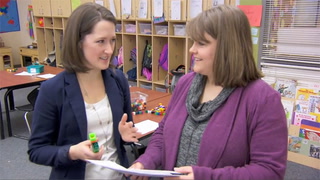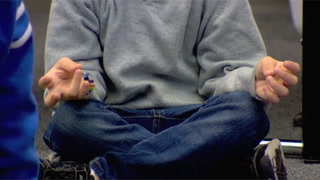Building Emotional Literacy Transcript
Card:
Tch
TeachingChannel
+++ 00:00:04 +++
Kristin Alfonzo: Come on in. Hello. I'm glad you're back today. Good morning.
Kristin Alfonzo: We use a strategy to help kids come in and start their day off on the right foot.
Card:
Classroom Strategy:
Building Emotional Literacy
Card:
Kindergarten Class
South Shore PK-8, Seattle WA
+++ 00:00:21 +++
Kristin Alfonzo: We use three minutes of silence, which has been an important part of our school since it was founded about ten years ago.
Lower Third:
Kristin Alfonzo
Kindergarten Teacher
South Shore PK-8, Seattle WA
+++ 00:00:28 +++
Kristin Alfonzo: Apart from that, we also use the Ruler program, which is an emotional literacy curriculum, essentially, and the mood meter is an important strategy or component within the Ruler program. The mood meter is a four part square, essentially, with four colors, and it helps kids think about how their body is feeling emotionally, and also physically. So every single morning when students come in, they start by charting themselves on the mood meter and thinking about where their energy is. Is
+++ 00:00:57 +++
their energy high or low and are their feelings positive or negative. That puts them in a color on the mood meter. Then depending on what color they are in, they can start to think about strategies they can use to help get them into a place where they can do their best learning.
+++ 00:01:10 +++
Kristin Alfonzo: I can tell from some of our energy, it seems like many of us are in the yellow today. So that means silence is going to be extra important, isn't it, Leila? Even though we have all these visitors and exciting things in our room, we still have to be our very best selves. Who has an idea for what strategy they will use to help them get themselves into the green during silence today? Solaya, what's your idea?
Student: Closing my eyes.
+++ 00:01:35 +++
Kristin Alfonzo: Solaya's going to close her eyes. Anyone else going to close their eyes? Yeah. Does anyone else have a strategy they want to share. What are you going to do?
Student: The fingers.
Card:
The fingers
+++ 00:01:46 +++
Kristin Alfonzo: The fingers. I was thinking about doing that one today too. So maybe you'll close your eyes like Solaya. Maybe you'll count backwards like Mignette. Maybe you'll do your fingers. So you choose for yourself. When Rainier sees that we are ready and quiet. It's going to be up to Rainer to see when we are ready for silence and he will turn the timer for us.
+++ 00:02:03 +++
Kristin Alfonzo: We start with checking in every morning. It's a nice way for me to kind of see who's maybe feeling sad or maybe someone who's feeling really grumpy and I need to keep an eye on for the start of the day. And then the three minutes of silence is a way for our whole school to come together and put everything at home behind us, and start our day on a fresh start.
Card:
2nd Grade Mathematics
Graham Hill Elementary, Seattle WA
+++ 00:02:24 +++
Sarah Dietz: Let's all get our mood meter journals out. I want you to be using your mood meter journal to help you get your body from the yellow back into the green, getting ready for math to start.
Sarah Dietz: Math takes place right after our lunch recess and we first come in and do about five to ten minutes of quiet time that we use the mood meter here at the school.
Lower Third:
Sarah Dietz
2nd Grade Teacher
Graham Hill Elementary, Seattle WA
+++ 00:02:46 +++
Sarah Dietz: And so the language is getting ourselves into the green, which is a place of calmness and readiness to learn.
Sarah Dietz: Use what you know to move your body into the green. Take some deep breaths. If you need water, you can give me the water signal.
+++ 00:02:58 +++
Sarah Dietz: The students come in from recess. Sometimes they're agitated. Sometimes they're angry about something that happened at recess, or they are maybe still feeling very hyper and wild and they just need to calm their bodies. So we just take ten minutes to still our bodies, and we have strategies that they use to calm their bodies, such as deep breathing.
+++ 00:02:17 +++
Sarah Dietz: I'm looking around. I'm seeing some kids using their getting in the green strategies, putting their heads down, taking some big deep belly breaths to calm their bodies down.
Sarah Dietz: I play a video that kind of guides them through that, and they also have a journal where they can write what they're feeling. Getting to a point where the room just feels settled, and then I know that they're ready to start learning.
+++ 00:03:41 +++
Sarah Dietz: In about 30 seconds, we're going to put our mood meter journals away and come to the carpet.
+++ 00:03:47 +++
Sarah Dietz: It's a good strategy, because if they are not feeling settled, they won't be able to engage with the lesson. They won't be mindful of what's happening during the lesson. And it's also just a life skill that we need to learn to prepare ourselves and be ready for the task that's at hand. And in this case, the task was math.
Card:
Tch
TeachingChannel















37 Comments
Gordon Harry Feb 22, 2024 9:44pm
1. By using hte 3 minutes of silence at the beginning of the day, it can calm kids down and get them in a place where they can begin to focus on the tasks that they will do that day. Essentially, they are teaching them meditation stratagies.
2. The teachers can know where the kids are at emotionally so that they can use the stratagies avaliable to them to help the students move into the green. The students can do some self reflection and have time to process their feelings and emotions to move into the green.
3. I have kind of eluded to it, but they learn how to calm their emotions and meditate to find a way to get their minds in a place where they can effectively study.
I would like to comment, I am wonder how effective something like this would be at the secondary level.
Conseta Williams Sep 17, 2023 9:07pm
This video was very informative. Beginning the day with three minutes of silence allows the teacher to help the students regroup. It will set the tone for the morning. As the students sit in silence you can monitor and see the students that maybe off to rocky start. The mood meter allows the students to express to the teacher how they are feeling. There were several strategies the students used I really liked the self management strategies. This shows independence and how the students could use in daily activities.
C. Williams
Rosanne Gutierrez Jun 20, 2023 11:41am
Starting the day with 3 minutes help reflect on what has already previously happened and taking it from upfront and putting it behind us. Knowing what we need to work on and what we can set aside for later, helps students center themselves and bring everything down for the classroom and learning. The mood meters allows not only the students see their emotions but also so the teacher is aware and can approach the child differently because they know their emotions as well. Self regulating tools are counting down from 10, deep breaths, closing eyes, focusing on an object until the timer goes off.
Taffany Jones Nov 13, 2022 7:46pm
1) Beginning the day with three minutes of silence is a great way for students to center themselves by relaxing their bodies and calming their minds. It also sets the tone for beginning the new day in class. This helps them be better prepared for receiving instruction and following class rules throughout the day.
2) The Mood Meter is a visual device that guides students with simple, suggested methods to help them move from less appropriate to more appropriate states of mind and being.
3) Students learn various self-regulation strategies like the very simple, but highly effective, technique of deep breathing, while journaling helps students identifiy more precisely what they are feeling and how to manage those feelings. At the same time, students are honing their writing and spelling skills with this strategy. Students learn to automatically implement the various strategies even when away from school and at home as well.